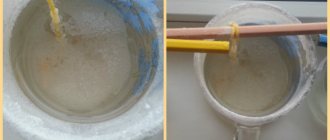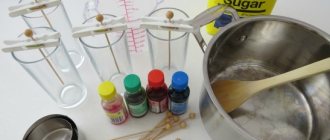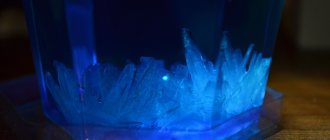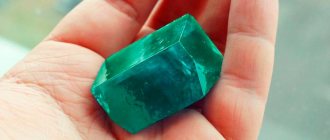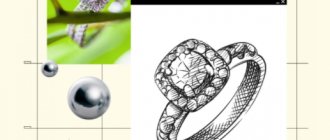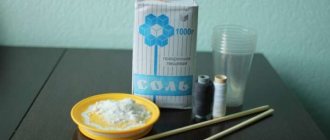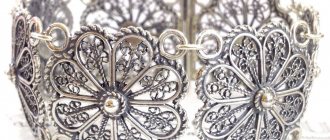Published Oct 11, 2019
Growing a beautiful crystal from copper sulfate, salt or other ingredients at home will require some effort and patience. But it can be a fun activity, especially for schoolchildren.
A crystal can be grown from various substances. As a rule, salts and organic acids are used. You can get them at pharmacies, household chemical stores or specialized outlets. The growing room should have a constant room temperature and average air humidity.
Growing crystals from copper sulfate (CuSO4 5H2O)
You can get copper sulfate (copper sulfate) at any store that sells fertilizers. In appearance, these are small crystals in the form of a bright blue powder.
You need to take:
- copper sulfate - 0.2 g;
- distilled water;
- filter paper;
- glass or plastic container.
Before purchasing, you need to carefully inspect the powder so that there are no lumps or green crystals in it. This is a sign of moisture penetration, and such vitriol is not suitable for growing.
A solution of high-quality vitriol will be bright blue.
The growing container can be made of glass or plastic. Practice shows that it is still better to choose plastic, since crystals stick to it less easily.
Step by step steps:
- First you need about 100 g of vitriol, which is poured in small portions of hot water, stirring constantly. Undissolved copper sulfate crystals should appear at the bottom.
- Next, we pass the still warm solution through filter paper and place it in a cool place.
- After 24 hours, crystals form at the bottom of the solution. We select the largest of them and filter the solution again. Crystals should not be touched with hands, so as not to leave traces of sweat that inhibit growth. If you need to adjust the crystal in the container, use medical gloves.
- Then we put the selected crystals into a clean solution. There are two options: put the crystals on the bottom (they will grow in length and width) or hang them on a fishing line (they will grow throughout the entire volume).
- Cover the container with a sheet of paper to speed up the growth of the crystal.
- Every 5–7 days, filter the solution and remove small crystals. Pour clean liquid into the growing crystal. As a result, in a month you should get crystals up to 3–4 cm in diameter.
Video: how to grow a crystal from copper sulfate
FAQ
I can't grow a crystal on a wire. What to do?
Two fundamentally different cases are possible. In the first, crystals form at the bottom of the test tube rather than on the wire. If this happens, carefully cut the copper wire so that there is a “fresh” cut at the tip that you lower into the test tube. Repeat the experiment starting from step 3 of the instructions.
The second case is when crystals do form on the wire, but there are many of them, they are small and “climb” on top of each other. Firstly, such a pile of crystals also looks pretty good! To grow one large crystal, repeat the experiment. To do this, carefully shake the crystals from the wire back into the test tube and follow the instructions starting from point 3
Please note that the water in point 10 must be hot! It will be possible to grow a large and beautiful crystal only if the entire system is cooled gradually
Using table salt (NaCl) at home
It is advisable to use regular rock salt, which can be purchased at any grocery store. Not suitable with additives (potassium chloride or iodine).
You need to take:
- table salt - 0.2 g;
- distilled water;
- glass container;
- filter paper.
Table salt dissolves equally well in warm and cold water. The problem with sodium chloride is that it forms a lot of small crystals. It is very difficult to grow a large specimen, as it consists of small structures that are easily destroyed.
However, they are beautiful in their own way due to the unique shape of each crystal. In addition, they can be painted in various colors. Printer ink or a solution made from the contents of felt-tip pens are suitable for these purposes.
The principle of cultivation is the same as with copper sulfate.
Growing sea salt crystals
Any sea salt for bathing, which is sold in pharmacies and regular supermarkets, will do.
You need to take:
- sea salt - 100 g;
- container for salt solution;
- distilled water;
- filter paper;
- fishing line (optional);
- pot.
Instructions for growing crystals:
Recent Entries
Patchwork with knitting needles: instructions for using the technique for beginners and amateurs How and with what to paint laminate flooring and is it possible to do it at all: we talk about the intricacies of the process Wedding invitations: a review of the best ideas with a detailed description of the manufacturing process
- Pour water into a container and add salt in small portions, stirring constantly until completely dissolved.
- Next, pass the solution through filter paper.
- After this, place the container with the solution in a saucepan and heat it in a water bath until hot.
- From the fallen crystals we select the largest ones and filter the solution again.
- We tie the crystals onto a fishing line and repeat the procedure of filtering the solution every few days, as with copper sulfate.
As a result, in a month you will get crystals up to 2–3 cm in size.
Whatever color the sea salt was, so will the crystals. If the salt is colorless, you can use dyes.
Video: table vs sea salt for growing crystals
Hygienic requirements
First of all, it is worth taking care of the necessary sterility in which the experiment should take place. Ideally, an amateur chemist's hair should be covered with a hat, and it is best to wear rubber gloves on his hands. Copper sulfate, if handled carefully and wisely, does not pose any danger to the human body.
All of the above precautions are needed primarily to protect the solution from dust and small particles of foreign materials getting into it. This is extremely undesirable, since other crystals may begin to grow on similar grains of sand that accidentally fall into the liquid, which will slow down the development of the main stone.
Lemon acid
Lemongrass is very soluble in water, making it difficult to grow large crystals.
You need to take:
- citric acid - 200 g;
- distilled water - 100;
- filter paper;
- container for solution;
- fishing line
Step by step description:
- Slowly dissolve 200 g of citric acid in 100 g of water, stirring constantly.
- Then we pass the solution through filter paper and leave the container in a room at room temperature so that cooling occurs as slowly as possible.
- The next day, crystals fall out, choose the most beautiful one and tie it to a fishing line.
- We filter the solution again and place the crystal in it.
- We repeat the procedure every 5–7 days. It is important to cover the container with the crystal with a loose lid so that the evaporation of water occurs more slowly.
- Remove small crystals on the surface of large ones with tweezers. In a month, a crystal up to 5–6 cm in length can grow.
Video: growing crystals from lemongrass
How to grow a crystal in one day
This can only be done with copper sulfate. True, the result is not one large crystal, but a large polycrystal consisting of small crystals.
You need to take:
- copper sulfate - 200 g;
- glass jar - 500 ml;
- fishing line;
- pot;
- distilled water.
Step by step steps:
- Dissolve copper sulfate in water at a temperature of 80˚C, stirring constantly until a precipitate begins to appear.
- Then filter the solution.
- We tie a bead to the fishing line and place it in the solution (a crystal will form on the bead).
- Cover the jar with gauze and leave it in a room at room temperature. After 10 hours the crystal will grow.
- We take out the crystal and filter the solution. After this, heat the solution in a water bath in a saucepan until it boils. We wait until it cools down a little and place a crystal on a fishing line in it.
- The crystal will begin to grow again and in 10–12 hours will reach large sizes.
Video: growing crystals in a quick way
Useful tips
The rate of the crystallization process is directly affected by the saturation of the solution. After a couple of days, you can remove the crystal from the prepared solution and change the solution to a more saturated version.
Growing crystals is a fascinating process that allows the younger generation to develop a cognitive interest in natural science subjects.
If the process is too slow, you can expect to get one large crystal. At a high rate of crystallization, there will be many small crystals among the products.
Growing radiant crystals
Radiant crystals are sold in special sets for schoolchildren.
The set contains all the necessary elements:
- chemical reagent;
- pallet;
- cardboards;
- instructions.
Sequencing:
- We take cardboard strips and cut them into 4 parts and stick them into the pallet. Fill in the reagent and wait 24 hours.
Safety
Wear gloves before starting the experiment.
Conduct the experiment on a tray.
Take precautions when working with boiling water.
General safety rules
- Do not allow chemicals to come into contact with your eyes or mouth.
- Keep people away from the experiment site without protective glasses, as well as small children and animals.
- Keep the experimental kit out of the reach of children under 10 years of age.
- Wash or clean all equipment and fixtures after use.
- Ensure that all reagent containers are tightly closed and stored properly after use.
- Make sure all disposable containers are disposed of correctly.
- Use only the equipment and reagents provided in the kit or recommended by current instructions.
- If you have used a food container or glassware for experiments, throw it away immediately. They are no longer suitable for storing food.
First aid information
- If reagents come into contact with your eyes, rinse thoroughly with water, keeping the eye open if necessary. Contact your doctor immediately.
- If swallowed, rinse mouth with water and drink some clean water. Do not induce vomiting. Contact your doctor immediately.
- If reagents are inhaled, remove the victim to fresh air.
- In case of skin contact or burns, flush the affected area with plenty of water for 10 minutes or longer.
- If in doubt, consult a doctor immediately. Take the chemical reagent and its container with you.
- In case of injury, always seek medical attention.

